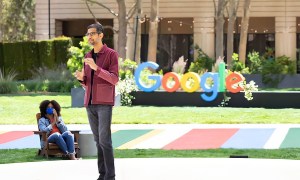
Most of us have imagined a future when we can view holographic images of people in three dimensions. You know, where you push a button and your loved one pops up in your living room? At Google I/O 2021, we realized the dream of viewing a model of our loved ones in person might just be closer than we think. Google’s Project Starline is working to make it possible for you to view a life-sized 3D model of a family member or friend when communicating with them, therefore enhancing personal interaction and mimicking the experience you get when talking to someone face-to-face.
To use Project Starline, users sit at a desk that almost resembles a vanity, as it’s surrounded by lights and it has a mirror-like window in front of the user. As the user and the guest chat back and forth, the person on the opposite end looks like they’re actually sitting at the table. However, it’s really a virtual representation created by lights and compressed data. Google describes the experience you get when using Project Starline as though you’re “looking through a sort of magic window, and through that window, you see another person, life-size and in three dimensions. You can talk naturally, gesture, and make eye contact.”

The reason why it’s so difficult to create a life-like model like this is that it requires a great deal of data, computing power, camera advancements, and accuracy. Google is using research in areas like machine learning, real-time compression, and spatial audio to make this possible. The search giant also developed a light field system that allows you to see volume and depth in an image without the need for glasses or another augmentation device like a headset.
As of right now, you can’t purchase a device that uses the technology, as it’s only available in a few of Google’s offices and it requires custom equipment. However, over time, Google wants to make it more affordable to the general public. We’ll be watching for Project Starline technology, and we’ll keep you posted on any new developments in the future. For now, we’ll just have to keep video chatting, but we’re excited to see what comes of Project Starline.


